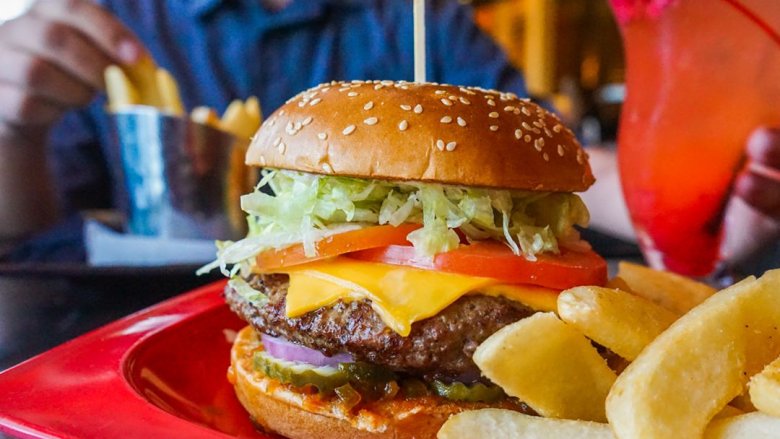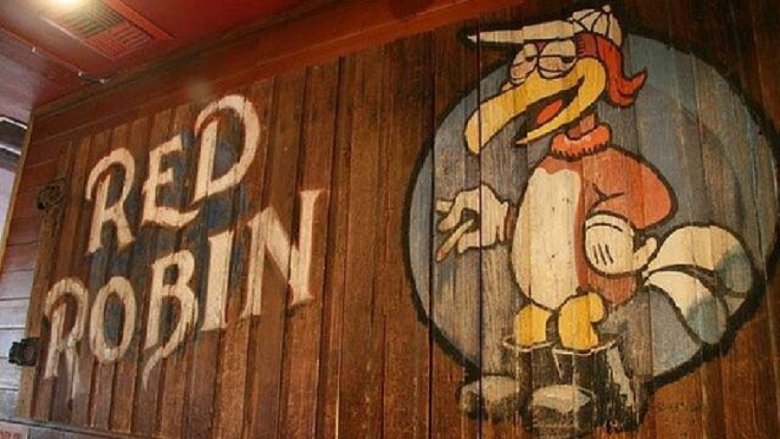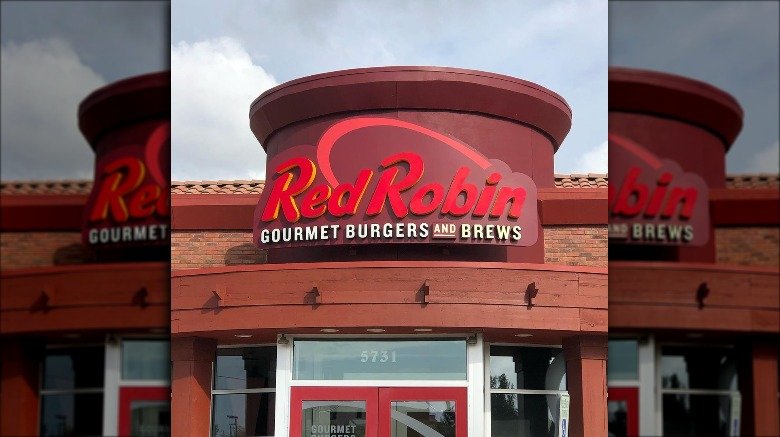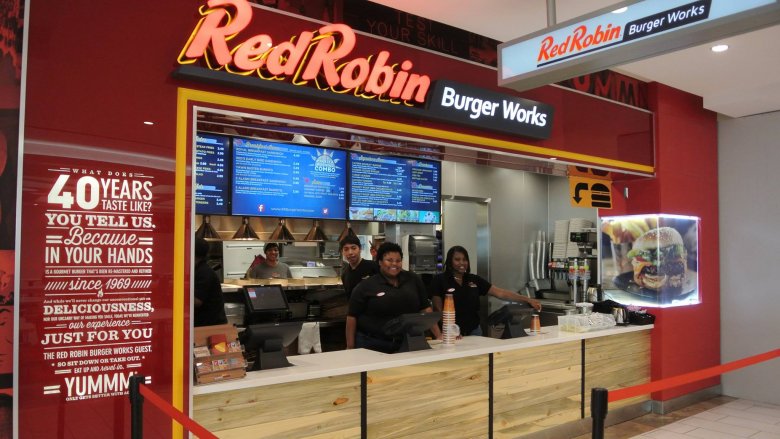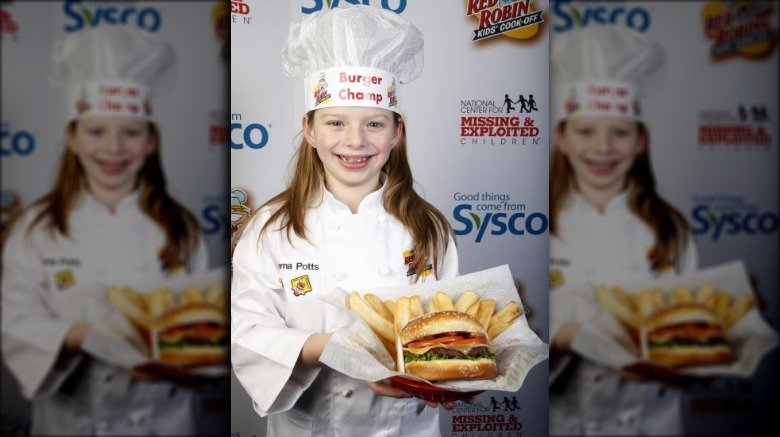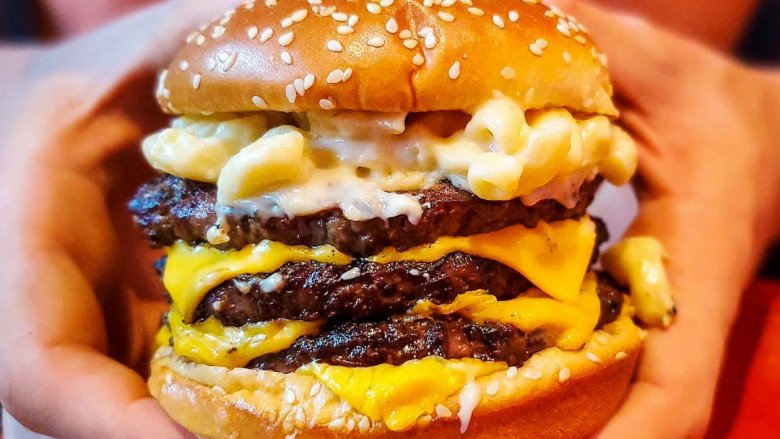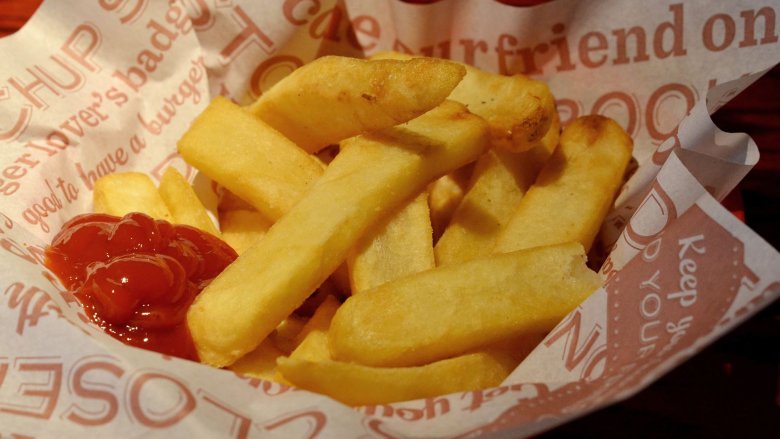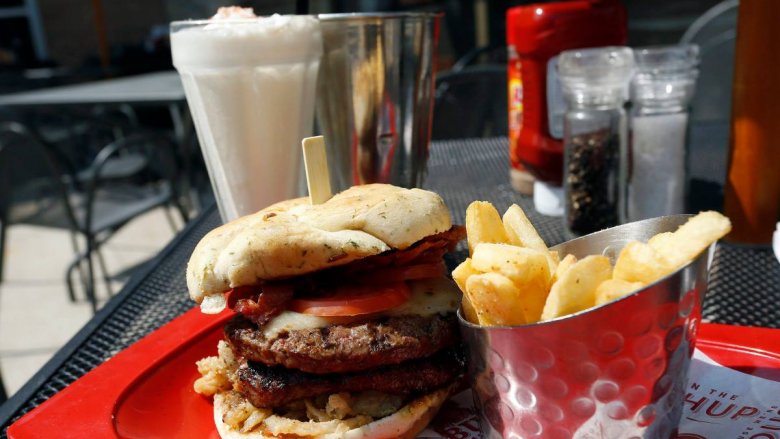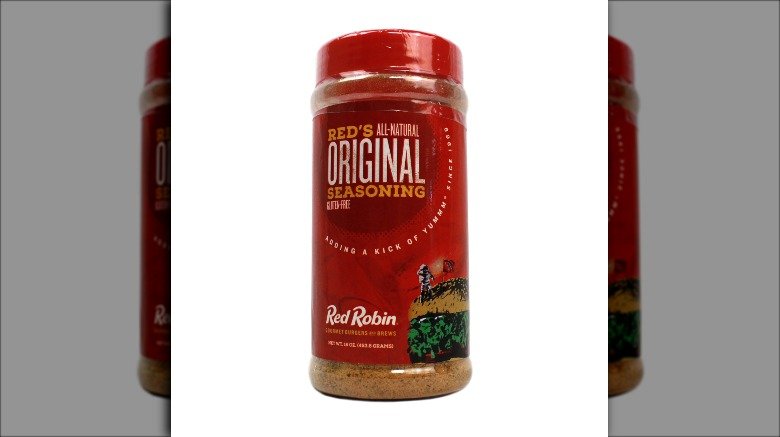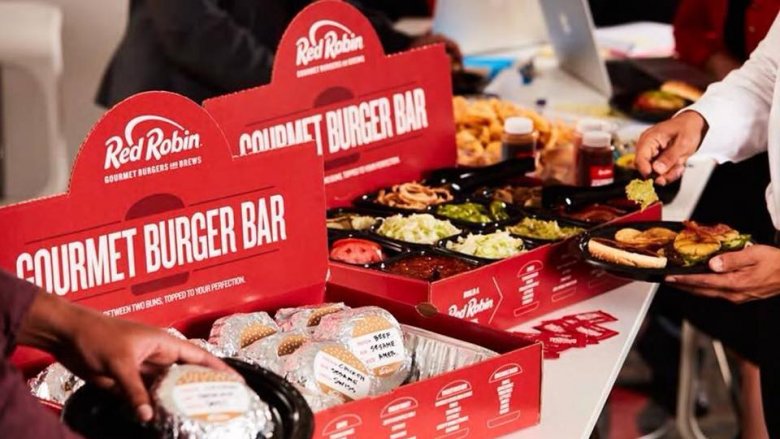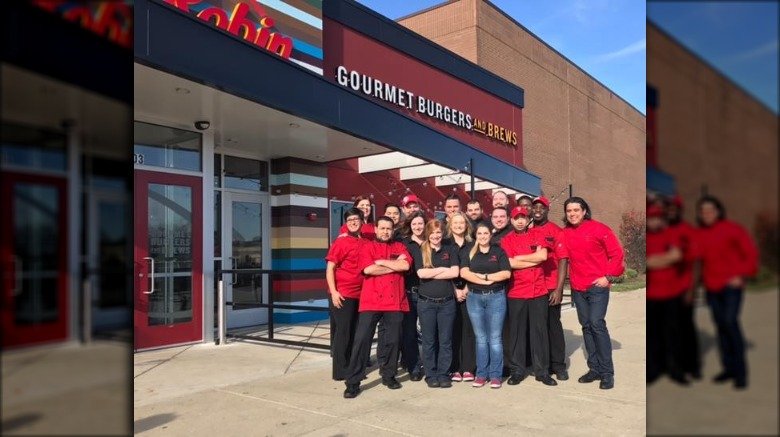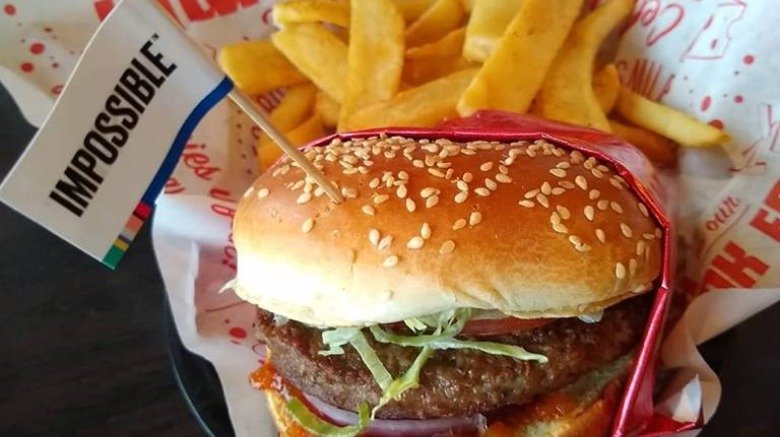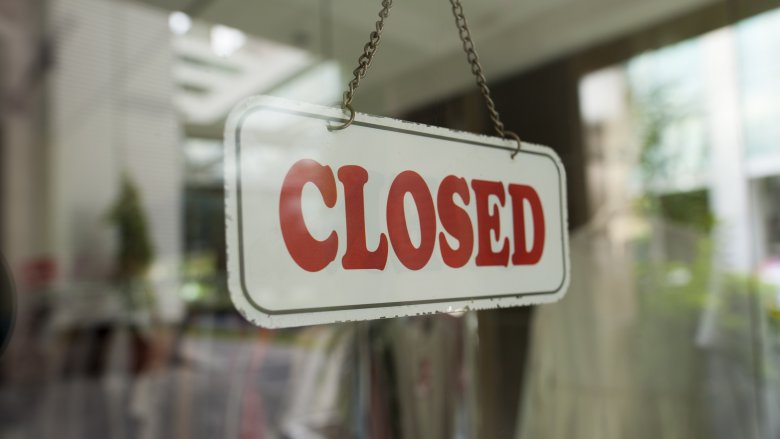The Untold Truth Of Red Robin
Especially in the chain restaurant market, it can be hard to stand out, but Red Robin and its blue-eyed bird mascot have been boasting their variety of gourmet burgers and unparalleled value for decades. They have been puttin' an egg on burgers since 1973, along with other unique ingredients and flavor pairings such as cheese sauce and fried jalapenos, luring burger lovers in to constantly try something new.
With its over 560 locations between the U.S. and Canada, Red Robin is a pretty recognizable establishment. But despite Red Robin's big, in-your-face burgers and monster-sized shakes, the chain's beginnings were fairly humble. They've explored a lot of new, innovative things along the way, trying to make Red Robin the best burger chain around — not all of which turned out well for the burger joint. And even for those who head to their neighborhood Red Robin to consume copious amounts of steak fries on a weekly basis, there may still be a few things left to learn about the company. We took a deep dive into this burger joint to learn a bit more about it. This is the untold truth of Red Robin.
Red Robin started as a bar
Red Robin's specialty wasn't always delectable burgers — and they weren't always called Red Robin. The chain was originally named Sam's Tavern, after its owner, Sam, when it opened in the 1940s. According to Red Robin's history, Sam sang in a barbershop quartet He had a particular love for the song "When the Red, Red Robin Comes Bob, Bob, Bobbin' Along," ultimately leading him to change the name of the establishment to Sam's Red Robin.
The original location sat close to the University of Washington campus in Seattle, Washington, and it was primarily a college hangout until it was eventually transformed into the burger-slingin' restaurant we all know today.
A man named Gerry Kingen bought the tavern in 1969 and a few years later, slowly started adding food to the menu. He completed a remodel and reopened with a bang. "I basically created a grownup's McDonald's," Kingen told the Seattle Times. But as for the original location now? It was closed in 2010 after the building was deemed too much of an investment to get the old structure up to par with other restaurants.
The first Red Robin franchisees were regular customers
In 1979, business was going well for Kingen and his burger joint, growing in popularity among University of Washington students. The spot proved to be a hangout for many, including the two customers who launched the company's first franchise.
Red Robin regulars, brothers Mike and Steve Snyder, loved the chain so much they opened the first franchise in Yakima, Washington, after forming the Snyder Group Company. The following year, the up-and-coming chain expanded into Portland, Oregon to open its second location and continued to grow from there. In 2000, the Snyder Group merged with Red Robin, and together opened the chain's 150th restaurant, continuing their nationwide expansion. Red Robin continued to grow, opening another 100 locations in the next four years.
There's still an operational Red Robin in Yakima, but not in its original building. The original franchised location was remodeled into a shopping plaza, now hosting shops and restaurants, and a new Red Robin building was constructed in 2014 not far from the original building.
Red Robin tried to launch a fast-food model
After the full-service burger joint continued on their winning growth spree, they decided to kick it up a notch. Red Robin announced their "fast-casual" model, introducing their new brand Burger Works, in 2011. The model was the perfect idea — offer a BYOB (Build Your Own Burger) menu, with the option of beef or chicken, along with 13 free topping options, and 10 "fancy" option that came at an additional cost. The chain also served fries, as well as beer and wine, and items were offered at a lower price point than its big brother Red Robin.
The first location opened in Denver, Colorado, but it didn't last long. After opening a total of 12 Burger Works locations, Red Robin decided to call it quits in 2016, closing nine of those locations and re-branding the remaining three as Red Robin Express.
Red Robin's Senior Director of Communications, Kevin Caulfield, told the Chicago Tribune the fast-casual environment was pretty competitive and the trial units weren't performing as well as the company would have liked.
Red Robin gave kids the chance to develop burgers for the menu
With the focus of gourmet burgers on the menu, Red Robin has constantly introduced new combos to impress their burger-loving guests. Often introducing something new and craveable, there are more than two dozen burgers on the menu, and over the years, Red Robin has utilized the help of youth cooks along the way to gain inspiration.
Red Robin hosted their Kids Cook-Off contest annually for a few years, with the first competition held in 2006. In 2007, 11-year-old Joey Yarwick won the prize with his "Au Brie Burger," featuring melted brie cheese and au gratin potatoes on a toasted croissant, and it was put on the menu the following summer for Red Robin guests to try.
The following year, Charlie Beckett, a 7-year-old from Idaho made up the "Holy-Peno Burger," featuring Pepper Jack cheese and jalapenos. Oddly enough, Red Robin still features a Burnin' Love Burger on the menu with Pepper Jack and fried jalapeno coins. The last mention of the contest in Red Robin's history listing the winners was in 2010 when 12-year-old Donovan Duggins won the grand prize with his "Mt. Vesuvius Burger." It appears the Red Robin test kitchen has taken recipe development into their own hands from now on though, since the registration website for the contest is now defunct.
There's a Red Robin secret menu, sort of
If you read Red Robin's history closely, you'll notice that they launched their "secret menu" in 2011. And while a secret menu for chains like In-N-Out means a hodge-podge of cult favorites, for Red Robin it really just means ultimate customization.
With the launch of their iPhone app, as well as online ordering, guests were given the opportunity to customize pretty well any burger to their liking. Choosing a bacon cheeseburger through their menu system, for example, would now give you the option to choose from seven different types of cheese, but the options go even further than that. A variety of options can be added on as well, included an extra patty, avocado, sautéed onions, an egg, and more.
According to Entrepreneur, Red Robin did try to offer a secret, solely word-of-mouth burger on New Year's Day in 2015, directed to help those struggling with a hangover after their New Year's Eve festivities. The "Cure Burger" was topped with a sunny-side up egg, bacon, and chili, but only mentioned through media coverage, social media, or word of mouth. But even if guests missed the memo, each of the burger components are still available to recreate the perfect hangover cure at any time through their customizer feature.
Red Robin has dished up bottomless fries for more than 20 years
One of Red Robin's most popular claims to fame is their bottomless fries. And while some may think it was a recent gimmick to attract more customers, it's actually been going strong for decades. In 1994 the chain introduced their bottomless steak fries concept, allowing guests to eat as many fries as they possibly could with their burger. Some guests take it even further and request an appetizer of fries to come out first before their main meal.
But bottomless steak fries aren't the only thing you can consume absurd amounts of. You can also order bottomless garlic fries or sweet potato fries (for an upcharge). Or, if you're watching your waistline, bottomless broccoli is an option as well.
And for some customers, those bottomless fries are serious business. According to one former Red Robin manager on Quora, those basket numbers can skyrocket. "One time we had a table of 3 regular size guys that went through 31 baskets of fries along with the meals they'd ordered," she wrote. "Ones like that will stick with you because you'd never think that they'd reach that amount."
Red Robin sold America's most unhealthy meal
Burgers aren't exactly known for their healthy qualities, but Red Robin took that one step further. In 2014, Red Robin took the cake for the unhealthiest meal combination in America. The meal essentially combines the most unhealthy options on the Red Robin menu including the "Monster" double burger, paired with bottomless fries and a milkshake, all rounding out to 3,540 calories.
The Monster double burger, with up to 1210 calories in just the burger, is still on the menu, but with Red Robin's custom menu options, you could easily top that number. The Royal Red Robin burger comes with 1110 calories, but any Red Robin burger can be "made a monster" by adding another patty and another 410 calories. Pair that double burger with a Monster shake and a few orders of fries and you could easily blow past that 3,500 calorie mark.
The daily recommended amount of calories is, on average, 2,000 for women and 2,500 for men. Luckily, there are lighter fare options at Red Robin, as well as bottomless broccoli as a side, because if you're not careful, a meal at Red Robin could easily set you back almost two days' worth of calories.
Red Robin has their own salty fry seasoning
There's something special that makes those bottomless fries so crave-worthy, making guests coming back to eat more. And the secret is in Red Robin's signature seasoning.
Red Robin utilizes their own signature fry seasoning, featuring a variety of ingredients. The seasoning combines salt, dried cane syrup, sea salt, dried garlic, onion and tomato, paprika, yeast extract and natural smoke flavor. The ingredients list also mentions "spices" in the mix, but we'll never know what that means. It is, after all, a special proprietary blend only used in restaurants or sold online.
And while we don't know the exact proportions of the seasoning's ingredients, we do know there's a whole lot of salt in the mix. According to the nutrition facts on the ingredient label, just ¼ teaspoon of seasoning will give you 300 milligrams of sodium, or 13 percent of your daily value. There are 210 milligrams of sodium in one order of their Bottomless Steak Fries, almost as much sodium as a Medium Fry from McDonald's, so be careful as you're chowing down. Basket after basket of those fries can really add up with that seasoning.
You can order your own Burger Bar from Red Robin
Despite their fast-casual model failing, Red Robin has had success in introducing to-go options and catering menus. They didn't introduce their online ordering and catering until 2017, but it has continued to grow in popularity ever since.
The catering menu features a variety of platters with wraps and sandwiches, along with salads and sides such as mac and cheese and boneless wings. But the real winner in the catering category is the Red Robin Burger Bar, allowing you to pick up a catering package complete with ten or more burgers, all made-to-order with your choice of cheese and bun. And with the bar comes the option for ultimate party customization.
Red Robin packs up all of the toppings for you, including the typical lettuce, tomato, pickles and onions. But so that you can truly create the Red Robin experience at your party, bacon, crispy onion straws, and even Chipotle Aioli or Bourbon BBQ sauces are included as well.
A few of Red Robin's management decisions backfired
Over the years, minimum wage spikes have not been on Red Robin's side, causing a slew of rash policy decisions to attempt to alleviate the effects.
A lawsuit in 2015 eventually ended in a Red Robin franchise paying out $1.3 million to settle a class action lawsuit. According to The Morning Call, the franchise had allegedly been requiring servers to share their table tips with employees in the kitchen who assisted in food prep or expediting of orders. The Morning Call states, "The suit alleges the company paid its servers $2.83 or $3.33 per hour, then claimed a tip credit to make up the difference of the $7.25 an hour minimum wage. The kitchen workers were illegally being paid less than minimum wage and included in the tip pool to make up the difference, the suit claims. The servers sought to recover the share of tips paid to the kitchen workers."
But that wasn't the only policy put in place to combat the effects of minimum wage hikes. According to Fox News, the chain eliminated the busser position from all of its restaurants in 2018. Chief Financial Officer, Guy Constant, told Fox News the change was needed to "address the labor increases we've seen," and, at the time, it was predicted the change could potentially save the company $8 million in 2018. Unfortunately, the change resulted in longer wait times for customers, ultimately dragging down customer satisfaction and numbers of return customers.
They got into trouble with vegetarians
It's no shock that Red Robin embraces the burger-loving culture. After all, that is what they were built on and they continued to run with it. But as more and more people are turning toward plant-based eating, Red Robin took a stab at vegetarians in one of their commercials that definitely backfired.
In attempting to promote their many burger options the actress in the commercial stated, "We even have a garden burger just in case your teenage daughter is going through a phase," and people were outraged. Red Robin's Senior Director of Communications, Kevin Caulfield, told HuffPost that Red Robin has had the Gardenburger and the BOCA Vegan burger for years, but that didn't seem to matter once the commercial launched, leading vegetarians to feel that their lifestyle wasn't being viewed as legitimate.
One concerned guest posted on Red Robin's Facebook Page saying, "I always thought it was pretty cool that as a vegetarian I could go to Red Robin and get a veggie burger. But I just saw your new commercial... 'in case your teenage daughter is going through a phase.' Since Red Robin apparently has no respect for vegetarians, please just consider the times I ate there a phase I was going through." And she wasn't the only one with concerns — offended vegetarians flooded their social media to protest the commercial.
Red Robin closing a bunch of restaurants
Despite Red Robin's many clever advertising efforts, sales and guest counts were down after the first quarter of 2019, according to their newsroom. With a 3.3 percent decrease in restaurant revenue and a 5.5 percent decrease in guest counts, it's time to make a change. According to a news release, Red Robin was closing 10 restaurants, effective May 31, 2019, with seven of those restaurants located within a shopping mall. According to Nation's Restaurant News, Pattye Moore, who has served as interim CEO since April, said the company was "moving with urgency."
Red Robin had decided to halt new restaurant growth at the end of 2018 in order to refocus, but plans for continued growth in 2019 don't seem promising either. "We are actively working with The Cypress Group on selectively refranchising and reassessing our real estate portfolio," Moore told Nation's Restaurant News.
In conjunction with the company's search for a new CEO, they announced in a press release that their 2019 strategic priorities are still focused on "reinforcing Red Robin's compelling Value proposition" to increase dine-in revenue and to improve the guest experience, but only time will tell if they'll plan for additional growth or continue to shut down more locations.
